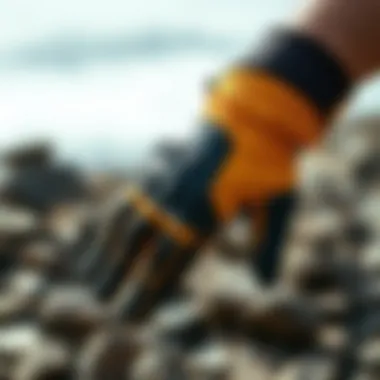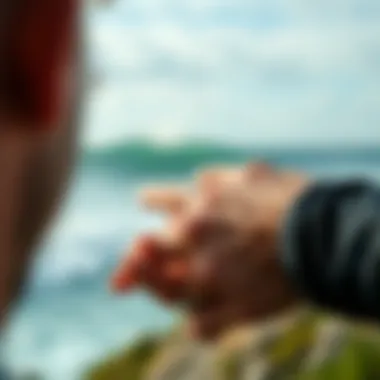Smart Techniques to Prevent Hand Blisters for Adventurers


Intro
Blisters on the hands can be a real pain, especially for those who enjoy activities like surfing, hiking, or even gardening. They form as a protective response when the skin experiences friction, heat, or moisture. For surfers, in particular, blisters can hinder performance and dull the thrill of riding waves. This article aims to furnish you with pertinent strategies to keep those blisters at bay through understanding the causes and implementing effective prevention techniques.
Recognizing the significance of preventing blisters is essential. Not only does it contribute to comfort, but it also plays a critical role in preserving your skin's health. From selecting the right gear to employing smart skin care practices, even small changes can make a world of difference.
Let's delve into the strategies and insights that will keep your hands healthy and functional, so you can focus on what truly matters—enjoying every moment out on the water or trail.
Understanding Blisters
Understanding blisters is crucial for anyone who engages in activities that put their hands at risk, whether that’s surfing, lifting weights, or mastering a musical instrument. They can not only be painful but also a hindrance to daily activities. By comprehending how blisters form and what causes them, you can take proactive steps to protect your hands. This section lays the groundwork for ensuring that blister prevention is effective and tailored to your lifestyle.
What is a Blister?
A blister is a small pocket of fluid that forms between the upper layers of skin, often as a response to an injury or irritation. Typically, it is filled with serous fluid, but it can also contain blood or pus, depending on the underlying cause. Blisters can develop on various body parts; however, they are particularly common on the hands and feet, where friction or pressure tends to occur.
Common Causes of Blisters
Blisters can arise from numerous factors, but primarily, they stem from mechanical or thermal injuries to the skin. In this section, we will delve into the particular causes of blisters that are most relevant to people with active lifestyles.
Friction
Friction is perhaps the most well-known cause of blisters, often occurring during repetitive motions. This repeated rubbing action can gradually cause the upper skin layers to separate, forming those telltale fluid-filled sacs. For athletes and fitness enthusiasts, friction can be a daily struggle. The key characteristic of friction blisters is their predictability; many people know the activities or gear that trigger them.
- Advantages: Being able to predict friction-related blisters means you can take steps to mitigate risks by choosing the right gloves or grips.
- Disadvantages: However, once a blister forms, it can be exceptionally painful and limit your ability to participate in activities you enjoy.
Burns
Burns lead to blisters as well, arising from exposure to heat or chemicals. Unlike friction blisters, burns can occur unexpectedly from accidents, making them a different beast altogether. The defining feature of burn-related blisters is their association with pain and potential scarring.
- Advantages: Understanding how these blisters form can help in developing safety measures, especially in environments where heat and chemicals are present.
- Disadvantages: They often indicate a more severe injury and can also require more specialized medical care, making prevention all the more important.
Allergic Reactions
Sometimes, blisters form due to allergic reactions to certain materials or substances, an often overlooked aspect. These blisters are typically accompanied by redness and itching, highlighting their association with the immune response. Individuals often experience discomfort because of an unknown allergy or sensitivity.
- Advantages: Being aware of possible allergens can empower individuals to choose materials and products that won't induce these reactions.
- Disadvantages: The unpredictable nature of allergic reactions can complicate this prevention strategy, as exposure might happen unexpectedly.
Medical Conditions
Certain medical conditions, such as eczema or pemphigus, can also increase the likelihood of blister formation. Here, blisters may develop not as a result of external friction or burns but rather due to internal factors. This category underscores the importance of understanding one's health status and collaborating with medical professionals.
- Advantages: By recognizing symptoms early, you can engage in a proactive dialogue with healthcare providers.
- Disadvantages: However, these conditions often require long-term management and treatment, complicating the blister prevention narrative.
How Blisters Form
Blisters form through a combination of damage to the skin layer and body response. Understanding the biological process helps in identifying preventive measures effectively. When the skin suffers irritations, the body reacts by sending fluids to protect the damaged area. This process sets the stage for blister formation and serves as nature’s way of facilitating healing.
Identifying Vulnerable Activities
Understanding the activities that put your hands at risk for blisters is crucial for preventing them. When you know where and how blisters are likely to occur, you can take proactive steps to protect your skin. Awareness helps to tailor your gear and preparation, making it easier to mitigate discomfort and injury during your chosen pursuits. Certain actions expose your hands to direct friction, moisture, or extreme temperatures, increasing the likelihood of developing blisters. By identifying these vulnerable activities, you can adopt methods that not only protect your hands but also enhance your overall experience in your hobbies or work.
Surfing and Hand Strain
Surfing is not just a sport; it's a way of life for many. However, the continuous grip on the board and waves creates notable strain on the hands. Water can soften the skin, making it more susceptible to friction. It’s essential for surfers to pay attention to their hands during long sessions. To minimize the risk of blisters, consider choosing boards with textures that provide better grip without excessive friction. Additionally, wearing well-fitted wetsuits or gloves specifically designed for surfing can add layers of protection.


Other Sports and Hobbies
Rock Climbing
Rock climbing presents a unique challenge. It demands a firm grip on rugged surfaces, which can lead to the formation of blisters, especially on the fingertips and palms. The primary appeal of rock climbing lies in its combination of physical strength and mental strategy. While it promotes fitness and camaraderie, the rough materials of climbing holds can cause significant abrasions, especially for beginners. Protective chalk can help with moisture management, but invest in climbing gloves designed to balance grip and protection. Regularly assess and condition your hands to withstand the rigorous demands of climbing.
Weightlifting
Weightlifting, a popular strength training activity, also poses risks to hand health. The constant pressure from barbells or dumbbells can lead to calluses and, ultimately, blisters if proper techniques aren’t applied. Weightlifters often develop thickened skin, which offers some protection but can also be a double-edged sword. A wise choice is to use weightlifting gloves, which provide cushioning and enhance grip. Moreover, establishing a routine of hand and grip strengthening exercises can help fortify your skin against future injuries.
Gardening
Gardening is often viewed as therapeutic, but it comes with its challenges, particularly for the hands. The contact with soil, tools, and plant materials can create friction and lead to blistering, especially for those spending extended periods digging or pruning. To combat this, gardeners should always wear gloves tailored for gardening. These not only provide a barrier against cuts and blisters but also enhance comfort while working with tools. Regularly applying moisturizing creams post-gardening can help keep the skin supple, reducing the chance of blisters in the long run.
Occupational Hazards
Manual Labor
For workers in fields like construction or landscaping, manual labor is a breeding ground for blisters. The nature of these jobs often requires prolonged repetitive movements with heavy tools, leaving hands vulnerable to damage. Acknowledging this, using high-quality work gloves is essential. They should fit well and allow enough dexterity to perform tasks without hindrance. Implementing a routine to check for signs of pressure and adjusting tasks can further mitigate blister formation.
Musical Instruments
Playing musical instruments can be a joyful endeavor, but it can also take a toll on the hands. Guitarists, for instance, often face blisters on their fingertips due to continuous contact with strings. To minimize discomfort, consider using lighter gauge strings or ensuring proper hand positioning during play. Incorporating gentle hand stretches and cooldowns between practice sessions can lessen strain and promote healing.
Crafts and DIY
Engaging in crafts and DIY projects puts hands through a variety of motions that can cause blisters. Activities like knitting, woodworking, or painting require repetitive hand motions and gripping of tools, increasing the risk of friction. To reduce these risks, invest in specialized gloves that add comfort while allowing precision. Additionally, taking breaks and employing different gripping techniques can prevent overexertion of specific muscle groups in the hands, ultimately preserving skin integrity and minimizing blister risk.
Prevention Strategies
Preventing blisters is crucial for anyone involved in activities that exert heavy use of their hands, such as surfing, gardening, or any sport. The goal of prevention strategies is not just to stop blisters from forming, but also to promote overall hand health. Having the right approach can save individuals from pain, downtime, and possible complications. This section dives into various tactics that can be integrated into daily routines or preparations before engaging in hand-intensive tasks.
Selecting Proper Gear
Gloves for Surfing
When it comes to surfing, gloves can make a significant difference. Surf-specific gloves are designed to provide both warmth and grip while minimizing the risk of blisters. A key characteristic here is the material, often neoprene, which offers a snug yet flexible fit. These gloves protect against the harshness of the surf while providing enough dexterity to manipulate the board. The unique factor of surf gloves is their ability to maintain warmth in cold water, which can sometimes lead to tighter grips that might create friction. However, if not fitted well, they can reduce mobility, affecting performance.
Grip Tape for Tools
For those who frequently use hand tools, grip tape presents an effective solution. This tape enhances grip on handles, reducing the effort needed to hold tools securely. The key characteristic of grip tape is its textured surface, which adds friction between the hand and the tool. This can be particularly beneficial for tasks that require repetitive motion. A notable advantage of grip tape is its adaptability; it can be cut and tailored to fit various tools. However, one disadvantage is the need for frequent replacement, especially with heavy use, as wear can diminish its effectiveness.
Comfortable Footwear
While blisters may primarily form on the hands, they can also occur on feet due to poor footwear. Comfortable shoes with good arch support and cushioning can indirectly help prevent hand blisters by promoting proper posture and movement. The unique feature of quality footwear is its padded design, which can reduce the strain on legs and hips, leading to more relaxed upper body movements. Although investing in comfortable shoes might seem secondary to hand care, discomfort in the feet can lead to altered gripping techniques, inadvertently increasing the risk of blisters.
Skin Preparation Techniques
Moisturizing
Moisturizing is an essential practice that helps maintain skin elasticity and hydration, reducing the chances of blister formation. The key point about moisturizing is that it softens the skin, making it less likely to tear under stress. A unique advantage of a good moisturizer is that it can create a barrier against friction while keeping the skin pliable. It’s important to note, however, that applying too much can lead to a slippery grip, so balance is key.
Exfoliating
Exfoliating regularly can assist in removing dead skin, making the hands softer and more resilient. This technique is procured by using abrasive scrubs or tools, and it serves to encourage the growth of healthier, younger skin. The important aspect of exfoliation is its ability to prevent build-up of rough patches that are prone to blistering. However, excessive exfoliation may lead to irritation or sensitization, which is a compromise to consider.


Protective Sprays
For those who engage in high-friction activities, applying protective sprays can add an extra layer of defense against blisters. These sprays often contain ingredients that create a barrier on the skin, reducing the impact of friction. The key feature of protective sprays is their lightweight formulation, allowing them to be worn throughout the day without discomfort. While these products can be quite effective, the downside can be their temporary nature, requiring reapplication during longer activities.
Timing and Technique
Gradual Exposure
When starting a new activity or increasing intensity, gradual exposure is vital. This strategy involves incrementally increasing the amount of time spent on hands-intensive tasks. The critical aspect of this technique is its ability to adapt the skin and muscles to stress, reducing the likelihood of sudden blisters. A unique advantage is that it also builds strength over time. Nevertheless, a potential downside is that it requires patience, as results may not be immediately visible.
Technique Adaptation
Adjusting your technique based on the task at hand can also aid in blister prevention. This involves being mindful of grip styles or the way your hands move during an activity. The important characteristic of technique adaptation is its focus on efficiency, promoting body mechanics that are less likely to cause strain. However, there’s a learning curve involved, as changing techniques can feel awkward at first.
Prevention is always better than cure, especially when it comes to blisters on hands. By investing time in proper strategies, you can ensure your hands remain blister-free and ready for any challenge.
Recognizing Early Symptoms
Understanding the early signs of blister formation can make a significant difference in preventing skin damage and maintaining overall hand health. Recognizing these symptoms is like having a competitive edge; it enables you to address potential issues before they escalate. If you’re hands-on with surfing, sports, or any manual task, knowing how to identify these signs early allows for immediate action. This section delves into critical indicators that signal the onset of blisters, offering insights on how to respond effectively to keep your hands in optimal condition.
Signs of Impending Blisters
Redness
Redness is often the first visible indicator that something’s off with your skin. When you notice a reddish hue forming, it’s not just a cosmetic issue; it’s your body’s response to irritation, generally signaling that the skin is under stress. Redness occurs due to increased blood flow in the area as your body attempts to repair itself.
This characteristic of redness can be particularly advantageous; it serves as an alarm bell, alerting you to take preventive measures. If you catch it early, applying a protective barrier like a blister pad or adjusting your grip on tools can significantly help. However, if left unchecked, redness can escalate into full-blown blisters, leading to painful setbacks in your activities, from surfing to gardening.
Tingling Sensation
A tingling sensation is another telltale symptom of blister formation. This can feel like a light prickling or slight numbness, often signaling that the layers of skin are starting to shift and separate due to friction. Recognizing this sensation is crucial. It’s a clear indicator that your skin doesn't appreciate the current activity or pressures being applied.
Tingling stands out as an important early warning sign. It allows you to reconsider your grip or adjust your technique before serious blisters set in. If you’re feeling this way, it’s time to lighten up and take a break, or switch to more comfortable gear to keep your enthusiasm intact.
Temperature Changes
Temperature changes in your skin can also point to the possibility of developing blisters. The affected area may feel distinctly warmer than the surrounding skin. This localized heat can be a result of friction and irritation, suggesting that the skin is beginning to falter under pressure.
Recognizing temperature shifts is beneficial as it provides a tangible cue for intervention. You might apply cold compress to help cool down the area or rethink your approach to the activity causing heat build-up. Monitoring these changes can be particularly helpful for those involved in physically demanding pursuits, as it can indicate whether adjustments need to be made.
Maintaining Hand Health
Taking care of your hands is crucial, not only to prevent blisters but also to maintain overall hand health. Our hands are often neglected, working tirelessly in daily tasks and activities, exposing them to various elements that can lead to damage. Strong, healthy hands allow us to participate in sports, artistic endeavors, and practical work. Ignoring proper hand care can lead to discomfort and irreversible problems.
In this section, we will discuss daily skin care routines and techniques to strengthen your hands. Each part plays an interconnected role in reducing the risk of blisters and ensuring durability and flexibility of the hands.
Daily Skin Care Routines
Cleansing
Cleansing is the first step in any effective skin care routine. It helps to remove dirt and sweat from the skin’s surface, allowing for proper functioning and reducing irritation. A gentle cleanser that is suitable for your skin type should be chosen, as harsh soaps can strip essential oils and lead to dryness. Proper cleansing not only keeps your skin clean but also prepares it for further moisturization, ultimately creating a protective barrier against friction that leads to blisters.
One key aspect is to use lukewarm water instead of hot, as that can exacerbate dryness. Opting for natural, hypoallergenic products can be a beneficial choice, especially for those with sensitive skin. A unique feature of thorough cleansing is its ability to reveal healthy skin, which can promote better skin resilience. The downside may include the need for consistency, as neglect can lead to accumulation of grime and irritation.
Moisturizing


Moisturizing is essential for maintaining hydration levels in your skin. A well-hydrated epidermis is less likely to experience tears or blisters since it remains pliable and resilient. Choose a moisturizer that is rich in emollients and humectants, catering to your specific skin needs. Applying moisturizer regularly, especially after washing hands, can markedly improve skin texture and prevent dryness.
What sets effective moisturizers apart is their ability to seal in moisture. Products with ingredients like hyaluronic acid or glycerin have shown to be popular for this purpose. However, be cautious as some heavily fragranced products may cause irritation. Focus on the unique need of your skin—different activities might demand specific moisturizing formulas.
Sun Protection
Sun protection is a non-negotiable aspect of hand care, especially for outdoor enthusiasts. Prolonged exposure to the sun can lead to skin damage, premature aging, and an increased risk of skin cancers. Using a broad-spectrum sunscreen with a high SPF on the hands is crucial, as the skin there is often thinner and more vulnerable.
Opting for water-resistant sunscreens is particularly necessary for individuals who engage in water sports, like surfing. The added layer acts as a shield, but it's essential to reapply it regularly after sweating and swimming. A unique feature of quality sun blocks is that they often include antioxidants, which can provide additional protection from environmental stressors. However, the need for reapplication can be seen as a downside, yet staying protected is worth the effort.
Strengthening Techniques
Strengthening your hands is not only about preventing blisters but also about enhancing endurance and flexibility. Common technique practices can significantly elevate hand health.
Hand Exercises
Incorporating specific hand exercises into your routine can greatly improve strength and dexterity. Simple tasks such as squeezing a stress ball or using rubber bands for resistance can promote circulation and enhance grip strength. Hand exercises encourage flexibility, which is vital for activities that put stress on the hands, such as weightlifting or gardening.
Regular practice of these exercises will yield noticeable improvements in grip strength and endurance. The unique aspect of hand exercises is that they can be done almost anytime—whether you’re watching TV or sitting at your desk. On the flip side, consistency is key; neglecting to do them may mean losing all that hard-won strength.
Grip Strength Training
Grip strength training is particularly valuable for people who engage in intensive manual activities like climbing. Exercises focusing on squeezing, pinching, and gripping can enhance both strength and endurance, directly contributing to the prevention of blisters. While there are numerous tools available, even simple DIY options can be highly effective.
This training not only strengthens the hands but can also improve coordination and overall performance in various disciplines. A unique advantage of grip strength training is that it often directly translates into better performance in sports and tasks. Nevertheless, overtraining can lead to strain, so it's important to find a balance and allow for proper recovery.
Keeping your hands healthy requires a balanced approach of care and training. A little diligence goes a long way in achieving comfort and functionality in daily life.
First Aid for Blisters
Blisters can be a real pain, quite literally, and knowing how to handle them can make all the difference. Effective first aid for blisters ensures that you manage the situation quickly and correctly, minimizing discomfort and promoting healing. Proper care can not only reduce healing time but also lower the risk of infection. For anyone who is active—especially surfers, athletes, and outdoor enthusiasts—being equipped with the right knowledge to tackle blisters is an essential part of hand health.
Immediate Care for Blisters
When you spot a blister forming, immediate action is crucial. First things first, resist the urge to pop it. Popping can introduce bacteria, turning a simple blister into an infection.
Here’s a step-by-step guide to handle a blister:
- Clean the Area: Start by washing the affected area gently with soap and water. This helps remove any dirt and bacteria, creating a less risky environment for healing.
- Protect the Blister: Use a sterile bandage or gauze to cover the blister. If it's large, you might want to use a blister-specific bandage, which is designed to cushion and protect.
- Avoid Irritation: Try to limit further friction on the blister. This might mean taking a break from activities or adjusting your gear, like using different gloves or grips.
- Monitor for Infection: Keep an eye on the blister for signs of infection, which would include increased redness, swelling, warmth, or pus.
- If Necessary, Drain: If the blister is particularly large and painful, you can drain it carefully. Sterilize a needle with alcohol, gently pierce the edge of the blister, and let the fluid escape. Always clean the blister afterward and cover it again.
By following these simple steps, you help maintain your hand's health and prevent complications.
When to Seek Professional Help
While many blisters can be treated at home, there are situations when it's sage to bring in the professionals. Here are a few instances where a trip to the doctor is advised:
- Signs of Infection: If redness radiates from the blister, or if it's becoming increasingly tender or warm.
- Severe Blistering: When blisters occur in clusters or are unusually large, they might warrant medical evaluation, especially if they are causing significant discomfort.
- Underlying Conditions: If you have diabetes or any condition that affects circulation, it’s wise to consult a healthcare provider early to avoid complications.
- Chronic Blisters: If you find you're getting recurrent blisters in the same area, it may indicate an underlying issue which would be best assessed by a healthcare professional.
Observing these guidelines can empower you to manage blisters effectively. Remember, your hands do a lot for you, so keeping them in good shape through appropriate first aid is the key to ongoing functionality and comfort in your daily endeavors.
Finale and Takeaways
In wrapping up this guide, it's essential to underscore the myriad strategies and practices that can keep blisters at bay while engaging in hand-intensive activities. Blisters can be a real thorn in the side for surfers, gardeners, weightlifters, and even those involved in manual labor. Understanding how to prevent them has a direct impact on performance and overall hand health.
Here are some key takeaways to remember:
- Be Proactive: Don’t wait for blisters to appear before taking action. Identifying vulnerable activities and preparing your hands is crucial. Wear the right gear, like padded gloves for weightlifting or specialty grip tape on tools to minimize friction. This can significantly lower the risk of developing blisters.
- Skin Care Matters: Prioritize skin health by following a routine that includes moisturizing daily. Proper hydration and skin maintenance can fortify the skin barrier, making it less susceptible to irritation.
- Listen to Your Body: Recognizing early signs can be a game changer. If you feel unusual sensations, such as tingling or warmth in certain areas, it may be your body’s way of signaling that a blister is on the way. Immediate action—like resting or adjusting your technique—can save you from discomfort later on.
- Invest in Quality Gear: High-quality, well-fitted gear can go a long way. Equipment tailored to specific activities not only enhances performance but also safeguards your hands. Always research options that prioritize both comfort and protection.
- Educate Yourself: Staying informed about the conditions that foster blister formation, whether it’s excessive moisture, heat, or pressure, can help you adapt your approach to different scenarios.
"An ounce of prevention is worth a pound of cure."
Finally, it’s about cultivating habits that promote long-term hand health. By integrating these strategies into your routine, you’re not just preventing blisters; you're investing in your body's ability to perform at its best. Whether you’re slicing through waves, tackling climbing routes, or, simply, doing daily tasks, keeping your hands blister-free enhances your quality of life.
For further reading on hand care and blister prevention, consider visiting resources like wikipedia.org, health.gov, or reddit.com. Keep your hands happy and healthy!















